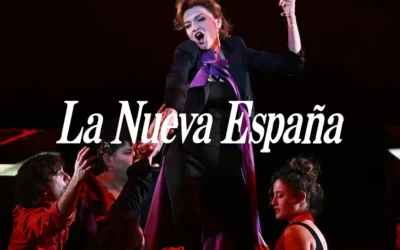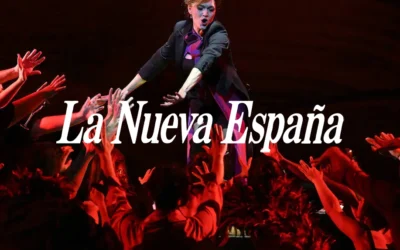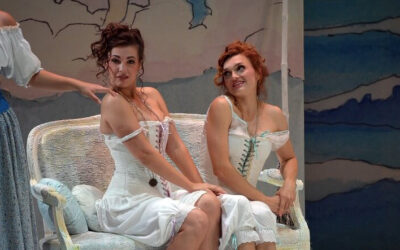Ópera de Oviedo 2023-24 Review: La Traviata / By Mauricio Villa / Ekaterina Bakanova

Ópera de Oviedo finished the 2023 year with a polemic new “Traviata,” by director Paco Azorin and co-coproduced with the Festival Castell de Perelada, a splendid cast of singers and the energetic approach of its conductor, Òliver Dìaz.
Paco Azorin is one of the most talented and prolific Spanish stage directors and set designers today. He sets the opera in an abstract space full of pool tables, which not only change positions in the space, but the floor also raises itself up to vertical or deep inclined positions where acrobats played different actions like walking or slow movements in the wooden vertical platform. The production is abstract with an intelligent use of lights and projected videos, by Pedro Chamizo, which define very powerful and meaningful spaces. But besides the strong visual, plastic and atmospheric designs, Azorín is a “theatrical animal.” Every action is carefully directed, building up a coherent story always truthful to the libretto and the music. Not only the main roles, but every single small character like: Gastone, the Doctor, the Baron or Annina are clearly defined, and the scenes are non-stop and full of action. Each movement is directed with intention and focus, keeping constant action making a fluid show. The choir and acrobat/dancers move constantly, however this became a distraction sometimes to clearly defining single characters. The choreography and movements, by Carlos Martos, follow Aozrín’s style by being powerfully meaningful rather than just beautiful movements in music.
To break the opera clichés, Azorín doesn’t doubt about placing characters who are not singing at that moment or even “in scene” in the libretto, so they can interact with each other in recitatives and arias, and therefore, they don’t have to sing recitatives or arias on themselves (which is one of the challenges about staging opera: to justify long arias where the singer is alone). He presented his own concept by introducing Violetta and Alfredo’s daughter from the second act onwards. He had previously showed in the overture how Violetta was longing for a child as she places a cushion under her clothes, and gives a feminist allegation as Violetta is wearing fashionable pants rather than a cocktail dress in the first act, or sings “sempre libera” with a stage full of women. This is a new modern approach, with clear intentions and believable acting which is in perfect communion with the music and the libretto.
Cast Highlights
The soprano Ekaterina Bakanova has turned the role of Violetta into one of her signature roles, and it really shows, not only in her singing but in her acting as well. It’s astonishing the way she constantly coughs without hurting her voice. She has a true lyrical instrument with a full-bodied middle and central register and a secure metallic high range. Her voice has grown in volume and harmonics and although her coloratura was clean and vast it was very noticeable that her voice was not comfortable with the high tessitura and vocal pyrotechnics of the first act. Nonetheless, she delivered an unexpected thunderous high E-flat at the end of “Sempre libera.” Her performance increased and developed during the second act, drawing the dramatic arch of emotions that Violetta was going through in her duet with Germont, with strong dramatic high A’s and B-flats in contrasts with whispering and mourning moments like “dite alla giovine” which she sang in a soaring pianissimo. She performed an extremely moving “amami Alfredo.” Her interpretation and vocal characterization were full of constant contrasts, dynamics and dramatic intentions. After a powerfully strong short scene with Alfredo in “Mi chiamaste?…” in the second scene of act two, she went back to her sweet mezza voce and awesome pianissimo for “Alfredo! Alfredo!”
But the highlight of her performance was by far the third act, where she portrayed an immensely moving dying Violetta, full of despair and abandonment with a dramatic “Addio del pasato,” which was warmly rewarded by the audience on opening night, and final “death scene.”
The young Mexican tenor Leonardo Sanchez sang the role of the lover Alfredo. This tenor has a dark and beautifully warm timbre, a covered round sound and immaculate Italian diction. He was an ardent Alfredo full of passion, as he showed in his first act duet with Violetta: “Un di, felice, eterea…” where he sang beautiful legato lines in his steady projected middle range and secure round A naturals. The role of Alfredo is quite central, although it requires arduous ascensions to A naturals, and B-flats and a final (not written by Verdi) high C for the cabaletta. So, it is important to have a steady and secure middle range where most of the role is written. Sanchez showed his voice control and breathing technique and his immaculate fraseo, as well as the piercing brilliant high B-flat and high C of his second act cabaletta: “Oh mio rimorso!” He sounded violent and in despair in his scene with Violetta at Flora’s party in the second act, but romantic and remorseful in the final third act.
Giorgio Germont was portrayed by Juan Jesús Rodríguez. He possesses a beautiful dark and warm voice completely even throughout his register of big projection, with an astonishing fraso and breath support. His voice sounds like it is nearby, rather than coming from the stage. His stage presence is strong and meaningful, and from the moment he steps in for: “Madamigella Valery?” with an aggressive entrance, his performance becomes hypnotic. He sang with alluring long legato lines for his long duet with Violetta in act two: “Pura si come un angelo,” phrasing constantly around high F, which is a high and uncomfortable register for a bariton. He delivered a secure extra high F-sharp in:”E Dio che spira giovine.” The interpretation of his aria,”Di Provenza il mar, il suol…” was a true lesson of good singing and vocal characterization. He was authoritarian in his entrance at Flora’s party: “Di sprezzo degno…” and full of remorse for his last short intervention in act three. He was warmly received by the audience at the curtain call.
The Oviedo Filarmonia Orchestra and Opera de Oviedo choir-intermezzo sounded brilliant and strong. The conductor Óliver Díaz offered an ardent reading of Verdi’s score, being traditional in tempi but very detail in the timbrical contrast of the Orchestra section, offering memorable moments like the overture, the second act concertante or the whole third act. It was noticeable that orchestra, chorus, and soloist were in perfect communion, and that the strong outburst in forte from the orchestra never hid the voices.
Overall, this is a modern poetic new production by the talented Paco Azorín with a strong cast of singers and a powerful moving reading of the score by Óliver Díaz.
Articoli recenti
- La Nueva España – Sociedad – Ekaterina Bakanova – La Traviata – Ópera de Oviedo
- La Nueva España – Ekaterina Bakanova – La Traviata – Ópera de Oviedo
- L’Opera – Scoprire Mozart con Milo Manara – Ekaterina Bakanova
- El Comercio – Ekaterina Bakanova
- ZÜRICH/ Opernhaus: LES PÊCHEURS DE PERLES – Vom Running Gag der Perlenfischer



Commenti recenti